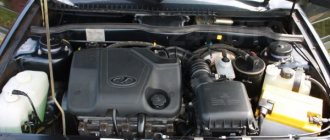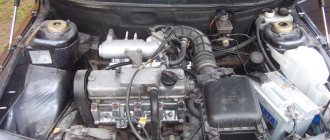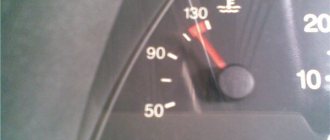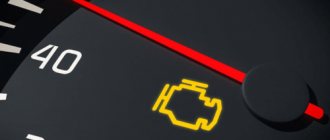If the VAZ 2110 8-valve engine, the 8-valve injector begins to show signs of instability in operation, this means that 1 of the cylinders has stopped performing its functions. Such a breakdown should be repaired immediately, because unburned fuel mixture enters the crankcase and changes the viscosity of the oil. As a result, the contacting surfaces of the unit parts are not covered with an oil film of sufficient consistency. There is increased wear of elements.
Causes of unstable engine operation
Content
When a VAZ 2110 engine with an 8-valve injector malfunctions, the reasons are sought in a certain sequence.
Systems and individual components are checked:
- electrician;
- cylinder operation;
- ignition;
- degree of depressurization;
- air supply;
- fuel injectors;
- pistons and rings;
- sensors
Electrics
When the engine of a VAZ 2110 8-valve injector malfunctions, the reasons, first of all, should be sought in the electrics.
Only after this is it possible to establish unstable operation of the cylinder. First, the candles are inspected:
- Using a special key, they are unscrewed sequentially.
- A superficial inspection of the insulator is being carried out.
- Often the cause of a weak spark or its complete absence is surface deposits, which are eliminated.
- Check that the spark plug gap is set correctly.
- The cap is inspected for wear.
When the VAZ 2110 engine has trouble with the 8-valve injector, the reasons may lie in the high-voltage wires. To do this, a tester is used that checks them for resistance, the optimal value of which is 5 ohms. If the wires do not meet this specification, they need to be replaced.
There is also a lack of spark due to the following reasons:
- ignition coil malfunction;
- broken wires.
The spark plug operation is checked in the following sequence:
- The spark plug tip is inserted into the wire.
- Its opposite end is applied in mass.
- The starter turns on.
- If a spark jumps, it means the element is working.
- If it is missing, the spark plug requires cleaning or replacement.
Cylinder operation
If the VAZ 21108 engine has 8 valve injector valves, then a possible cause may be poor cylinder performance.
When it is determined that everything is in order with the electrical part, the following actions are carried out:
- The hood lid is installed in the open position and the VAZ car starts.
- To determine the tripping of one of the cylinders, 1 wire is removed one at a time.
- Each time you should listen to the tone of the machine's noise. Her work must become unsustainable.
- If the next time you remove the wire, the sound does not change, it means that this cylinder has a malfunction.
Knowing that the voltage is coming through the wire, a search is being carried out for another reason why the VAZ 2110 engine is having problems with the 8-valve injector.
Ignition
VAZ 2110 engine 8 valves, the injector may trip if the coil is faulty.
To check, the following steps are carried out:
- The terminal is disconnected from the coil.
- It has 4 connectors: power, ground and 2 control lines.
- A multimeter is connected in series to each connector.
- The voltage at 1 connector must correspond to 12 V.
- At ground the resistance should be around 1 Ohm.
- By connecting the device to the control lines, the starter turns the crankshaft. The device should show at least 0.3 V.
If 1 of these indicators is not met, this will be the reason why the VAZ 2110 8-valve engine has an injector problem.
Depressurization of the system and air leaks
If the VAZ 2110 engine has trouble, the cause of the malfunction may lie in excess air supply.
As a result of depressurization, uncontrolled suction occurs, which leads to disruption of the functioning of the system. To check for a leak, carry out the following steps:
- There is a valve next to the air filter that closes.
- This leads to an artificial increase in pressure.
- It immediately becomes clear where the air leak is coming from.
Insufficient amount of air in the combustible mixture
If there is a lack of air in the combustible mixture, the VAZ 2110 8-valve engine and 8-valve injector may also begin to stall.
The following problems exist:
- The capacity of the air filter has deteriorated. This happens due to its contamination. To check the unit, dismantle it and start the car. If no changes are observed, then this unit requires replacement.
- Another reason why the VAZ 2110 8 valve injector troits is the throttle. This element needs constant monitoring. During maintenance, in parallel with changing the oil and all filters, this part must be cleaned. For this purpose, VD-40 is used, which removes dirt well from the surface.
Fuel injectors
VAZ 2110 engine 8 valves, the injector may triple due to a malfunction of the injectors, as well as the fuel rail.
To understand how faulty the injectors are, a stand is used that provides complete information about them. In some cases, they need cleaning, which is also carried out at the stand. The ramp is also subjected to external examination for cracks or dents.
Pistons and rings
A malfunction in the piston system often leads to the fact that the VAZ 2110 engine begins to misfire.
It depends on the mileage traveled by the car. Unstable operation occurs for the following reasons:
- There is wear on the rings and pistons. Not only is there an increased consumption of lubricant, but the operation of the unit also deviates from the norm. In this case, you should hurry up with a major overhaul.
- Piston burnout. This happens because the rings allow oil to pass through, which burns in the piston. This leads to their burning out.
- When the valves burn, the gap increases. As a result, exhaust gases begin to flow, and the car's performance deteriorates.
These reasons lead to a decrease in compression. It is checked by adding oil to the cylinder. If its performance has increased, then the piston group requires replacement.
Sensors
If sensors fail, this affects the unstable operation of the car. This is due to the fact that the nodes send a signal to the electronic unit. If it is absent, the receipt of commands to control the machine stops.
To identify a malfunction, each sensor is checked individually until the faulty element is found.
Ignition
Before checking the entire system, it is necessary to identify the inoperative cylinder. This is done as follows: the high-voltage wires are pulled off the spark plugs one by one.
At the same time, the working cylinders react to this action, the engine begins to wither. If the non-working cylinder is disconnected from the ignition, the engine will not react to this in any way. After determining the inoperative cylinder, unscrew the spark plug. Problems with it or with the ignition system are indicated by the presence of fuel residues on it, the spark plug is “wet”. You can try replacing the spark plug and installing another high voltage. You may find that when you start the engine, it runs fine. If this does not happen, you need to continue checking. The simplest solution is to replace your module with one that is known to work. If this is the problem, then the engine should start working correctly. Also possible. To do this, you need to measure the resistance at the terminals. This needs to be done in pairs. Combine cylinders 1 and 4, as well as cylinders 2 and 3. The resistance should be between 5.2 and 5.5 ohms. The ignition module cannot be repaired; if it malfunctions, it will have to be replaced.
Reasons for engine tripping 16 valve injector
If the VAZ 2110 engine has problems with the 16 valve injector, then the reasons have some features:
- High voltage coils. Their quantity is 4 pcs. They are located under the lid. It is removed during inspection. To establish the serviceability of each coil individually, the bolt located next to each element is unscrewed. Then the car starts and the terminal is removed. If the noise of the machine does not change, then the unit is faulty. Each coil is checked this way.
- Faulty sensors located on the crankshaft or camshaft lead to vehicle malfunction.
Crankshaft position sensor (CPS)
Often the engine stalls due to problems with the DPKV. To check, you will have to remove this sensor from the engine. Be sure to mark its position on the engine.
After removal, you need to measure the resistance of the sensor inductive coil. The multimeter should show a resistance between 550 and 750 ohms. Anything more or less indicates a sensor malfunction. It needs to be replaced. There are other testing methods, but they are “difficult to apply” in a regular garage.
Now a short video with another reason.
Causes of carburetor engine tripping
If the engine of a VAZ 2110 8-valve carburetor fails, then the reasons are as follows:
- Setting the quantity and quality of the mixture. The carburetor has mixture quantity and quality screws that need to be adjusted.
- If the engine of a VAZ 2110 fails, the reasons lie in clogged jets and idle channels.
- The gasket that allows air to pass through is broken. This makes the combustible mixture leaner.
- When the VAZ 2110 engine stalls, the cause may be a malfunction of the carburetor magnetic valve.
- The float system is not adjusted correctly. As a result, the fuel level decreases. This leads to the fact that the engine on the VAZ 2110 8 valves will operate unstably.
- The filters that allow gasoline to pass through are clogged.
- The ignition system distributor is malfunctioning.
If the engine in a VAZ fails, then you should start by checking the spark plugs. Most often the reason is their contamination. If this does not bring results, then you need to start looking for more serious reasons.
Nutrition
Often, the cause of engine tripping is the power supply system. First of all, the problem may be caused by low-quality fuel. To check, try changing the fuel. You can also try cleaning the injectors.
Their blockage can also cause tripping. For this purpose, special compounds are used. It is not recommended to pour cleaners into the tank. It is better to make a temporary power supply system; cleaning is carried out according to the instructions indicated on the package. After cleaning the injectors this way, the spark plugs should be replaced with new ones.
Why does the VAZ 2110 jerk when driving?
The phenomenon, which car enthusiasts call jerking, occurs due to a sudden change in the crankshaft speed when the gas pedal is in a stable pressed position.
If suddenly a VAZ 2110 jerks while driving, this causes anxiety and concern to the car owner. We need to do something urgently, but first we need to understand the reason. We will talk about some features of jerks and signals that help you understand why they occur.
During the start
Most often, when starting from a standstill, the highest stage of the jerk is observed - failure, that is, a very significant delay in the engine’s response to the pressed gas pedal. It happens that the engine stalls. It’s especially unpleasant when you’re standing, for example, in front of a traffic light, and someone behind you is already honking, and you’re frantically starting the car again.
A jerk when starting off occurs when the ECU (electronic control unit) gives a signal to start opening the throttle valve, that is, when transitioning from the XX mode to the driving mode.
Throttle position sensor
IN THIS WAY, THE QUANTITY OF FUEL SUPPLY THROUGH THE INJECTORS SHOULD INCREASE, WHICH DOES NOT OCCUR WHEN THE PRESSURE IS INSUFFICIENT IN THE FUEL LINE.
Potential culprits for the car moving jerkily when starting off:
- fuel pump , which is about to completely fail. This is evidenced by its peculiar periodic “howling” or an increase in its noise. The pump on an injection engine is listened to even before the engine itself is started - it is turned on initially from the battery, starting to pump fuel before turning on the starter. It is located inside the gas tank, so it becomes almost inaudible once the engine is running. In carburetor cars, the fuel pump is under the hood, you can hear it even when the engine is running;
- The fuel pump mesh is clogged with foreign particles that enter the gas tank along with low-quality gasoline at the gas station, or are formed in the tank itself due to condensation. This is why the gas tank should be flushed periodically;
- fuel filter , which is located under the hood. It also needs to be changed periodically;
- pressure regulator To replace it, you will need to remove and disassemble the fuel pump.
The first step is to check what pressure the fuel supply system produces. The check is carried out using a pressure gauge. It connects to a fitting located on the fuel rail (under the hood). We cannot give uniform readings, since it is different on different engines.
For some, a pressure below 325 kPa can be considered normal, while for others it is 400 kPa. That is, you need to look specifically at your instruction manual.
If the pressure gauge readings are too high, it means there is a malfunction in the fuel pressure regulator. If the readings are too low (less than 284 or 364 kPa, again, depending on the engine), replacing the fuel filter will help.
Air leak
The presence of excess air in the cylinders can cause tripping. Thus, excess oxygen can enter the power unit in several ways: through a broken head gasket, or be “sucked in” through the intake manifold gasket or injector.
The most common cause is a breakdown of the cylinder head gasket. To eliminate the problem, it is necessary to replace the gasket material. To do this you will have to dismantle the block head. This will allow access to the cylinders and valves, which also need to be diagnosed.
Conclusion
The main reason for the power unit tripping is a faulty spark plug. The selection of this component for the car must always be done. This will help you configure and adjust the unit correctly. Also, the fundamental reasons for tripping is the lack of the proper amount of air and fuel, which upsets the balance of the air-fuel mixture.
If the VAZ 2110 8-valve engine, the 8-valve injector begins to show signs of instability in operation, this means that 1 of the cylinders has stopped performing its functions. Such a breakdown should be repaired immediately, because unburned fuel mixture enters the crankcase and changes the viscosity of the oil. As a result, the contacting surfaces of the unit parts are not covered with an oil film of sufficient consistency. There is increased wear of elements.
Diagnostics
So, to determine the specific reason for the long start-up of an injection-injected internal combustion engine, you should start with a high-quality diagnosis. Usually, they check the compression in the cylinders. Its values must be within 12 atm for this to be considered normal. In this case, there should be no deviations between these indicators in each of the cylinders (maximum - 1 atm).
Then the spark plugs must be replaced. This will have an effect on the engine and it will now start much faster. However, if everything is not in order with the motor, then the normal starting time will last only 1-2 days.
Therefore, high-voltage wires should also be diagnosed. Diagnostics will make it possible to find out whether the cables have a breakdown, which is clearly visible by the spark coming out at night. This is done as follows: the car starts in the dark, at the same time you need to monitor which wire sparks.
The ignition coil also needs to be checked. Many experienced drivers do this: they install a known good and new module instead of the original one, then check the engine starting for several days. If everything is normal, the start-up does not take long - it means that the whole problem was in the bobbin (ignition coil).
If there are no changes, the test continues. This time you should test all filters, including the air filter. Next - check and replace all sensors and regulators
Pay special attention to the air flow sensor
The next stage: testing various connections, checking the wiring for good contact, cleaning the masses and flushing the throttle assembly.
If nothing changes again, then it is recommended to check the engine fan relay. It often causes similar problems with starting on a fuel-injected internal combustion engine. You can test the relay if you remove the wire from the temperature controller installed on the thermostat.
The fan should turn on after these steps. However, after measuring the resistance value on a warm internal combustion engine, the system can produce low temperature data, although the temperature inside the engine is clearly more than 90 degrees. Why is there such a difference? It turns out that this may well be a buggy DTOZH, which for some reason was not checked earlier. It must show the real coolant temperature, otherwise chaos will begin in the system, and it is not surprising that the engine takes so long to start.
Timing marks
If the camshafts are incorrectly aligned relative to the crankshaft
– the reason for the engine tripping. The opening and closing timing of the intake and exhaust valves will not coincide with the engine strokes.
For example, at TDC of the piston the valve may be closed, so a flash will occur not only in the cylinder, but in the intake or exhaust manifold, depending on which valve is not closed.
This may occur due to a stretched timing drive.
. As the chain or belt is used, it stretches. Therefore, the opening or closing angles may shift. This leads to engine tripping.
What to do
If you have checked everything: the spark plugs are in order, there is a spark everywhere, the quality of the mixture is at the right level, you need to check the timing marks. We look at the degree of belt tension. In the case of a chain, how “out” the tensioner is. If the marks are knocked down, then we set them as needed.
After troubleshooting, we fix the problem. If the motor stops running, the cause has been found and eliminated.
If the Lada Priora's starter does not turn
| Possible malfunction | Diagnostics | Remedies |
| Low battery | The voltage at the battery terminals without load is less than 12V. When trying to start the engine, a cracking noise is heard from under the hood. | Charge the battery or replace it with a new one |
| Oxidation of battery terminals or wire terminals, their fit is not tight | When you try to start the car, the voltage in the on-board network drops much more than at the battery terminals. In this case, a crash may be heard under the hood. | Clean the contacts, lubricate them with petroleum jelly and tighten the terminals |
| The engine or attachments are jammed | Check the rotation of the crankshaft, pump and generator pulley. | Repair engine, generator, pump |
| The starter is faulty, the starter drive gear or flywheel ring teeth are damaged | Remove and inspect the starter. | Repair or replace starter |
| The starter switching circuit or starter relay is faulty, the wires are damaged, or the ignition switch contacts do not close | When the key is turned to position “II”, the starter traction relay does not operate (a click is not heard under the hood). Check the +12V supply to the control contact of the traction relay. | Replace starter relay, wires, ignition switch |
| The starter traction relay is faulty, there is a short circuit or break in the retractor winding, the relay armature is stuck | When the key is turned to position “II”, the traction relay does not operate (there is no click under the hood), but + 12V is supplied to the control contact of the traction relay. Remove the relay and check its operation. | Replace the traction relay |
| Contacts or wires of the traction relay are oxidized, poor ground contact | When the starter is turned on, a clicking sound is heard under the hood, but the starter armature does not rotate. Using an ohmmeter, check the resistance of the Battery-Starter circuit, as well as the ground wire. If the circuit is in good condition, remove the starter and check the operation of the traction relay by applying +12V to it from the battery | Tighten the terminals, clean the contacts, replace the traction relay |
| Open or short circuit in the holding winding of the traction relay | When you try to start the engine, you hear a crashing sound under the hood. The battery voltage is within normal limits. We check the traction relay with an ohmmeter or by its excessive heating. | Replace the traction relay |
| Burning of the starter commutator, sticking of the brushes or their severe wear. Break or short circuit in the starter armature winding | The starter armature rotates slowly or does not rotate at all. Check the traction relay by applying voltage to the starter contact bolt directly from the battery | Replace starter or armature |
| Freewheel slipping | When the starter is turned on, the armature rotates, the flywheel is stationary | Replace clutch or starter |
Battery
The first thing you should look at is the battery. And it doesn’t matter whether we are talking about a hot injection engine or a cold one
It also doesn't matter at all how many valves it has. The batteries of all modifications of the VAZ model under consideration are of the same type
To find out why the Lada does not want to start, open its hood and look at the battery indicator. If the latter is missing, measure the voltage with a tester - 11.5 volts will be normal. Lower readings indicate the need to charge. When this is not the reason, then look further. Be sure to check if the battery terminals are oxidized. If so, clean them with fine sandpaper.
Carburetor faulty
Many car enthusiasts have wondered why the engine stalls at speed, especially in carburetor cars. This has to do with the fuel supply. If the carburetor is severely worn, fuel does not flow evenly into the cylinders, but, accordingly, either a lot or a little. In this case, after pressing the gas pedal to overtake or advance, fuel enters the intake manifold unevenly, the engine begins to “chop” and shoot into the exhaust.
To eliminate the malfunction, it is necessary to dismantle the carburetor and clean it with a bulkhead. To do this you will need a repair kit. Most motorists do not contact a car service center to carry out such an operation, but carry out the repairs themselves, since the procedure is quite simple. The only subtlety is the setting and adjustment of the injection element.
Solution methods
Now that the main causes have been identified, you can proceed directly to troubleshooting methods . Before we begin, it is worth noting that not all faults can be identified independently, much less eliminated. Let's look at what needs to be done to eliminate engine tripping.
Fuel rail and injectors
The most common cause of engine tripping is a malfunction of the injectors and fuel rail. To eliminate the cause, it is necessary to disassemble this element. The fuel rail is inspected for cracks and deformations. But with candles, not everything is as simple as it seems at first glance.
To determine the performance of the elements, they need to be run through a special stand, which will show whether the injector will work. If they become clogged, they must be cleaned at a nozzle cleaning stand, and if the element is completely faulty, then replace it with a new one.
Spark plugs and wires
Another reason why the power unit fails is the spark plugs and high-voltage wires. So, it is worth removing the elements from the engine and conducting diagnostics. Spark plugs, first of all, are inspected for integrity, and then checked on a special spark plug stand. If everything is in order with the spark plugs, then it is necessary to set the contact gap before installation.
High-voltage wires are checked with a conventional resistance tester. So, a good quality wire will have a resistance of 5 ohms. Deviation from this indicator is considered to indicate that the wires are not suitable for further use and must be replaced with new ones.
Sensors
Failure of several sensors can lead to the motor becoming unstable and tripping. This could be a failure of the TPS, IAC, camshaft sensor, or DMVR. When all these components fail, they signal the electronic engine control unit, which in turn outputs information to the driver. The malfunction can be eliminated by replacing the corresponding sensor.
There are two ways to determine the performance of the sensor - measuring each sensor one by one with a tester, or connecting to the on-board computer, where an error will pop up, decoding which you can determine the location of the problem.
Throttle valve
A faulty throttle valve can cause the engine to shake. To cure the malfunction, you need to dismantle the element and clean it. Today, there are a sufficient number of products on the auto chemical market that can be used to clean this unit.
But the most popular folk method remains carburetor cleaner, or VD-40. Both products clean out accumulated dirt and dust quite well.
Air filter
The air filter remains a known problem with engine tripping. Thus, untimely replacement of this element can lead to insufficient or incorrect formation of the air-fuel mixture. This is due to the fact that a dirty filter leads to poor air permeability and the engine simply begins to choke.
To eliminate the problem, it will be enough to replace the air filter element. Since the VAZ engine has simple design features, any motorist can cope with this task without much difficulty. So, to replace the air filter you need to get into the engine compartment. Then, unscrew the four bolts securing the air filter cover and change the filter element.
Symptoms of a problem
If you know about the main signs and symptoms of a motor malfunction leading to tripling, it will be much easier for you to solve the problems that arise.
There are several signs in total.
- The engine runs rough at idle, shaking and vibrations occur, which are clearly felt inside the cabin. This phenomenon cannot be confused with anything and the verdict is clear - one of the cylinders has failed. This symptom appears even when the unit is broken.
- Blackening of the electrode for spark plugs, presence of soot and soot. It is not enough to simply replace the spark plugs with new ones, since this does not eliminate the cause of soot formation.
- The exhaust changes its sounds. When tripping, the exhaust sound literally shakes the car. Experienced drivers notice this quickly and easily.
- The appetite of the power unit is noticeably growing. There can be many reasons for increased consumption, so a full diagnosis will be required.
- Dynamic performance decreases, speed and power drop. At low speeds it is not difficult to notice when picking up speed. But this can be caused by cylinder failure, that is, tripping, or other reasons.
- The revolutions are floating. This is easy to notice by looking at the tachometer needle. Changes, that is, fluctuations, can be serious or minor, in the range of 100 revolutions.
- When accelerating, you can feel the engine jerking in any gear.
To understand why the engine stalls at idle or in gear, you need to understand the possible reasons for this phenomenon.
Problems with the injection system
There are some specific problems with the injection system that can become
VAZ 2110 troits engine
The cause of tripping or similar problems with the VAZ 2110 engine:
- malfunction of the idle speed controller;
- clogging of injector nozzles;
- contamination of the fuel pump, fuel or air filter;
- failure of the mass air flow sensor;
- throttle position sensor failure;
- contamination of the engine crankcase ventilation system;
- ECU malfunction.
When a VAZ 2110 stalls when cold, but after warming up it works fine
Separately, it is worth mentioning the problem with the sensors that are equipped with the “tens” motors. Although they are inexpensive, as practice shows, they need to be replaced quite often. First of all, this is the notorious mass air flow sensor (MAF). Next to it, the throttle position sensor (TPS) falls into the risk group. It is also necessary to mention the idle speed controller (IAC), it is also popularly called the “idle speed sensor”. All of them, unfortunately, require systematic diagnostic testing.
VAZ 2110 troits engine
Along with this, the “crooked” firmware of the electronic control unit may prevent the engine from idling correctly. Such a problem may arise, say, after the car has been subjected to unreasonable tuning. As a result, good dynamics are observed at high speeds, but then the VAZ 2110 troits when cold and no longer holds the standard 1000 rpm at idle and even stalls. This problem can be solved by flashing the ECU in accordance with the version of the program recommended by the automaker. However, sometimes diagnostics also reveal defective ECUs, which reconfiguration does not help. In this case, it may be necessary to replace the control unit with a new one.
Additionally, when the engine injector of a VAZ 2110 fails, it makes sense to check the intake manifold for leaks. In this case, gaskets, vacuum hoses, and injector O-rings are checked. You also need to inspect the vacuum brake booster and manifold plugs. As a result of suction, excess air appears in the intake manifold, which leads to an over-lean mixture and misfire in the cylinder. This may cause the candle to become wet, which means it may lose its ability to ignite the compressed mixture. At the same time, it will not be difficult to detect the help at a service station, since specialists use a smoke generator. Likewise, it is important to check the fuel pressure at the rail.
Why does a diesel engine stall when cold?
The problem when a diesel engine misfires when cold is no less familiar than its gasoline counterparts, but the range of searches for causes is somewhat narrower. In this case, engine tripping is often accompanied by bluish or white smoke from the exhaust.
- Firstly, it may be airing.
- Secondly, there may be a problem with the glow plugs.
- Thirdly, the cold injector jams.
Here are the three main and most common problems that can cause a situation where a diesel engine stalls when cold. However, valve clearances and incorrectly set timing marks and fuel injection pumps cannot be ruled out.
But still, before checking and changing everything, you should remember that modern engines do not tolerate “blind diagnostics”; there are too many similar symptoms for different faults.
Air supply problems
Air supply is an integral element of the formation of the air-fuel mixture. So, due to the wrong amount of air, the engine runs hot. The main elements that affect this are the throttle valve and the air filter.
A dirty throttle body will not allow proper air flow. As a result, the throttle may get stuck in one position, and the engine will stop functioning normally. To correct the situation, it is necessary to remove the part from the engine, then clean the element and make sure that the valve is working. It is worth noting that cleaning can be carried out with special means, but carburetor cleaning liquid is also ideal.
Particular attention should be paid to the mesh of the mass air flow sensor. It regulates the position of the throttle valve. If dust has accumulated on it, then the recognition of the amount of air that goes into the engine is impaired. Accordingly, much more oxygen can enter the power plant than is required. This causes an imbalance in the mixture. Therefore, when cleaning the throttle valve, it is necessary to pay attention to the sensor grid and also clean it.
The air filter must be changed every 20,000 km. If this is not done, the engine begins to feel a lack of air, and in addition to tripping, a number of other malfunctions occur. The way out of the situation is to replace the element. This will help normalize the amount of air supplied to the cylinders and restore the balance of the air-fuel mixture.











